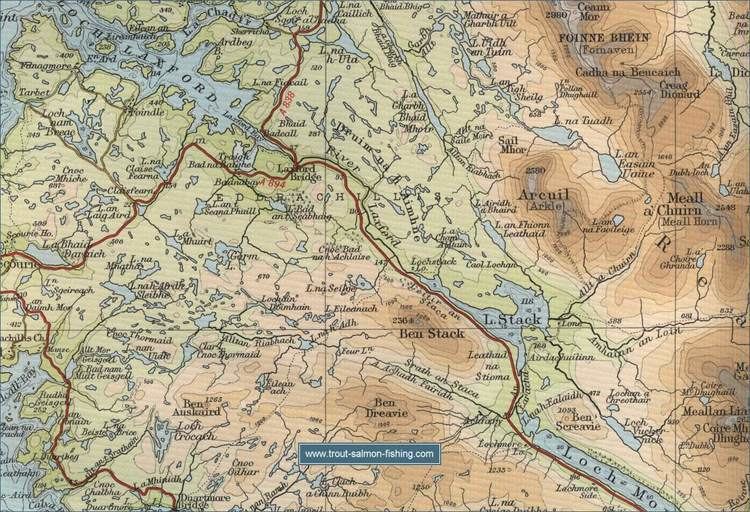 | ||
Laxford is a remote area in the far Northwest Highlands of Scotland around the River Laxford which runs northwest from Loch Stack to Laxford Bay. This bay is an inlet of Loch Laxford, a sea loch and Special Area of Conservation. The river is well known for its salmon fly fishing, indeed the name "Laxford" derives from the Norse for "salmon fjord". The area is important geologically, being a region of shear in the Moine Thrust. A road bridge, Laxford Bridge, crosses the river adjacent to the A838 and A894 roads, the road junction making the spot well known to tourists. Laxford is in Sutherland, in the Highland council area of Scotland; Scourie, 12 kilometres (7.5 miles) away, is the nearest village.
Contents
- Lairg to laxford bridge 2016 part 1
- River LaxfordEdit
- Loch LaxfordEdit
- GeologyEdit
- Laxford BridgeEdit
- References
Lairg to laxford bridge 2016 part 1
River LaxfordEdit
The River Laxford runs some 7 kilometres (4.3 mi) in a generally northwesterly direction from Loch Stack (by Ben Stack) to Laxford Bay. It has a catchment area of about 170 square kilometres (67 sq mi). The River Laxford is considered one of the more productive salmon rivers in northern Scotland with a catch of over 200 salmon in most seasons. Catches of sea trout, however, have declined in recent years.
Loch LaxfordEdit
Laxford Bay is an inlet of Loch Laxford, a fjard sea loch. The loch is a Special Area of Conservation, classified as a large shallow inlet and bay – it has a wide variety of marine habitats and species. Water conditions are mostly sheltered because of the reefs and islands but the outer region of the loch is very exposed. It has the most extensive shoreline of sheltered sediment in the far northwest of Scotland. There are many small islands in the loch.
GeologyEdit
Laxford is in the region of the Lewisian gneiss complex, deformed by Moine Thrust, which occurred during the Caledonian Orogeny. To the south are Scourian high-grade metamorphic rocks, some 3,000 million years (Ma) years old, intruded with undeformed Scourie dykes (2,400 Ma) whereas to the north are lower-grade metamorphic rocks, which were later deformed and metamorphosed during the Laxfordian orogeny. At Laxford, layers of pink granite and pegmatite intruded into hot gneiss about, million years ago. Alternating layers of black mafic gneiss and grey felsic gneiss are to be seen, cut across by steeply dipping sheets of granite and pegmatite.
Laxford BridgeEdit
At Laxford Bridge the A838 road, coming northwest from Lairg on Scotland's northeast coast, joins the A894 coming from Loch Assynt, which is to the south. The A838 then crosses the river at the bridge and runs northeast to Durness on Scotland's north coast.
